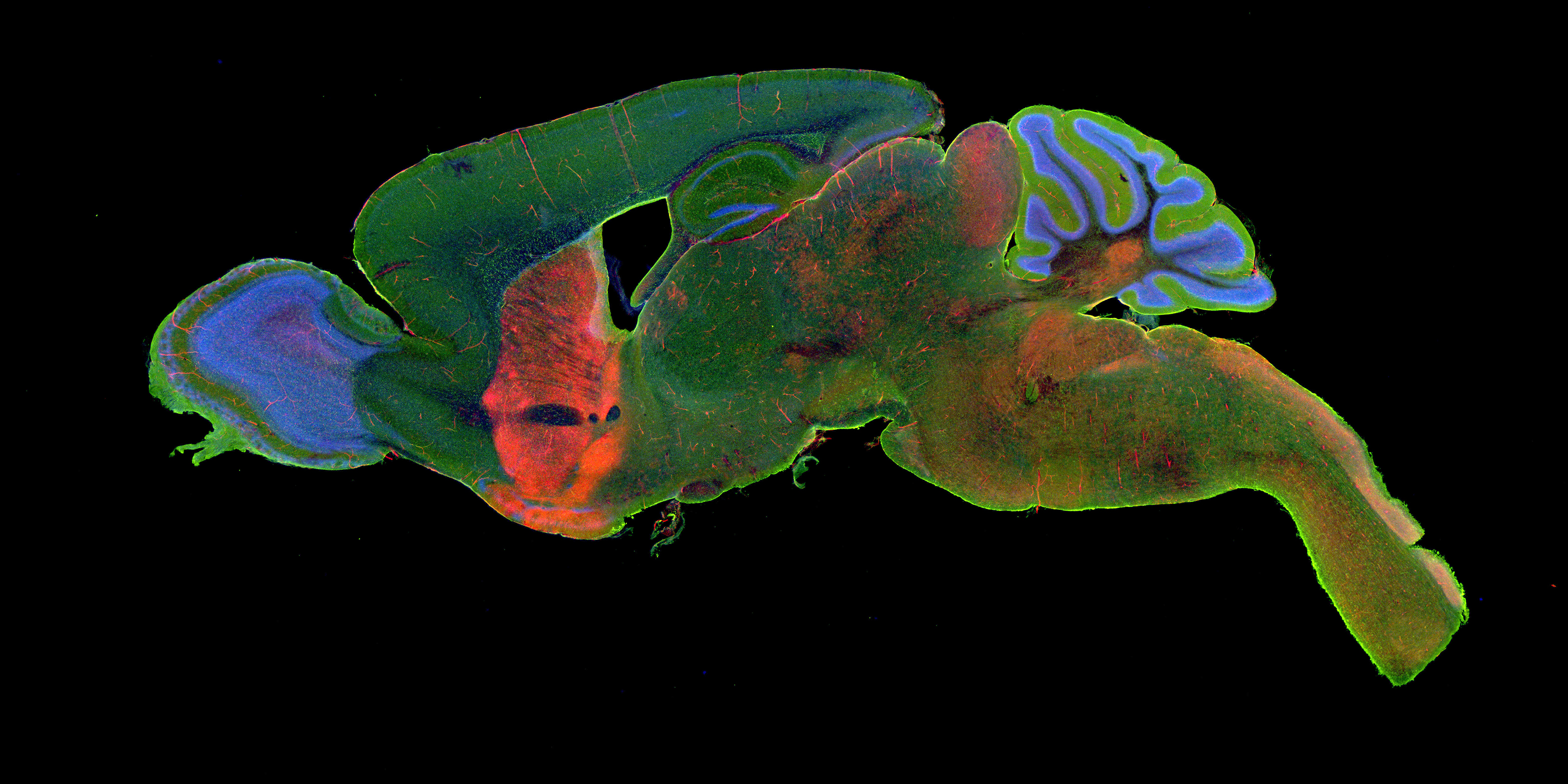A07 Project movie
A07
In project A07, we will investigate astrocyte-neuron and neuron-neuron communication downstream of cAMP signaling, and its role in hippocampal signaling deficits in murine experimental autoimmune encephalomyelitis (EAE), a mouse model of multiple sclerosis. By imaging cAMP signals using genetically encoded cAMP indicators we will characterize receptor-mediated cAMP signaling in astrocytes of healthy and EAE mice. Using the photoactivatable adenylate cyclase PACmn, the role of increased cAMP on astrocyte physiology and astrocyte-dependent regulation of EAE, immediate early genes and synaptic plasticity will be tested.
Dr. Christine Gee
E-Mail: christine.gee©zmnh.uni-hamburg.de
WWW: Dept. of Synaptic Physiology, Center for Molecular Neurobiology Hamburg, University Medical Center Hamburg-Eppendorf
Prof. Dr. Christian Lohr
E-Mail: christian.lohr©uni-hamburg.de
WWW: Division of Neurophysiology, Institute of Cell and Systems Biology of Animals, University of Hamburg
Dr Christine E. Gee
Selected publications (*equal contribution)
- Fieblinger T, Perez-Alvarez A, Lamothe-Molina PJ, Gee CE, Oertner TG. Presynaptic cGMP sets synaptic strength in the striatum and is important for motor learning. EMBO Rep. 2022 Aug 3;23(8):e54361.
- Anisimova M, van Bommel B, Wang R, Mikhaylova M, Wiegert JS, Oertner TG, Gee CE. Spike-timing-dependent plasticity rewards synchrony rather than causality. Cereb Cortex. 2022 Dec 15;33(1):23-34.
- Yang S*, Constantin OM*, Sachidanandan D*, Hofmann H, Kunz TC, Kozjak-Pavlovic V, Oertner TG, Nagel G, Kittel RJ, Gee CE*, Gao S* (2021) PACmn for improved optogenetic control of intracellular cAMP. BMC Biol 19, 227.
- Wiegert JS, Pulin M, Gee CE, Oertner TG (2018) The fate of hippocampal synapses depends on the sequence of plasticity-inducing events. eLife 7:e39151.
- Scheib U, Broser M, Constantin OM, Yang S, Gao S, Mukherjee S, Stehfest K, Nagel G, Gee CE*, Hegemann P* (2018) Rhodopsin-cyclases for photocontrol of cGMP/cAMP and 2.3 Å structure of the adenylyl cyclase domain. Nat Commun 9:2046
- Scheib U*, Stehfest K*, Gee CE*, Körschen HG, Fudim R, Oertner TG, Hegemann P (2015) The rhodopsin-guanylyl cyclase of the aquatic fungus Blastocladiella emersonii enables fast optical control of cGMP signaling. Sci Signal 8:rs8. doi: 10.1126/scisignal.aab0611. *equal contribution
- Gee CE*, Peterlik D*, Neuhäuser C, Bouhelal R, Kaupmann K, Laue G, Uschold-Schmidt N, Feuerbach D, Zimmermann K, Ofner S, Cryan JF, van der Putten H, Fendt M, Vranesic I, Glatthar R & Flor PJ. (2014) Blocking metabotropic glutamate receptor subtype 7 (mGlu7) via the venus flytrap domain (VFTD) inhibits amygdala plasticity, stress and anxiety-related behavior. J Biol Chem 289:1097510987.
- Fendt, M, Imobersteg S, Peterlik D, Chaperon F, Mattes C, Wittmann C, Olpe H-R, Mosbacher J, Vranesic I, van der Putten PH, McAllister KH, Flor PJ & Gee CE (2013) Differential roles of mGlu7 and mGlu8 in amygdala-dependent behavior and physiology. Neuropharmacology 72:215-233.
- Mang GM, Dürst T, Bürki H, Imobersteg S, Abramowski D, Schuepbach E, Hoyer D, Fendt M & Gee CE (2012) The dual orexin receptor antagonist almorexant induces sleep and decreases orexin induced locomotion by blocking orexin 2 receptors. SLEEP 35:1625-1635.
- Gee CE, Benquet P, Gerber U (2003) Group I metabotropic glutamate receptors activate a calcium-sensitive transient receptor potential-like conductance in rat hippocampus. J Physiol 546:655-64.
Prof. Dr Christian Lohr
Selected publications (*equal contribution)
- Wendlandt M, Kürten AJ, Beiersdorfer A, Schubert C, Samad K, Sauer J, Pinto MC, Schulz K, Friese M, Gee CE, Hirnet D, Lohr C (2023) A2Aadenosine receptor-driven cAMP signaling in olfactory bulb astrocytes is unaffected in experimental autoimmune encephalomyelitis. Front Immunol 2023 Nov 23;14:1273837.
- Hassani Nia F, Woike D, Bento I, Niebling S, Tibbe D, Schulz K , Hirnet D, Skiba M, Hönck HH, Veith K, Günther C, Scholz T, Bierhals T, Driemeyer J, Bend R, Failla A, Lohr C, Garcia Alai M, Kreienkamp HJ (2022) Structural deficits in key domains of Shank2 lead to alterations in postsynaptic nanoclusters and to a neurodevelopmental disorder in humans. Mol. Psychiatry. 2022 Nov 30.
- Fischer T, Prey J, Eschholz L, Rotermund N, Lohr C (2021) Norepinephrine-induced calcium signaling and store-operated calcium entry in olfactory bulb astrocytes. Front Cell Neurosci 15:639754.
- Beiersdorfer A, Wolburg H, Grawe J, Scheller A, Kirchhoff F, Lohr C (2020) Sublamina-specific organization of the blood brain barrier in the mouse olfactory nerve layer. Glia 68:631-645
- Beiersdorfer A, Scheller A, Kirchhoff F, Lohr C (2019) Panglial gap junctions between astrocytes and olfactory ensheathing cells mediate transmission of Ca2+ transients and neurovascular coupling. GLIA 67:1385-1400.
- Rotermund N, Winandy S, Fischer T, Schulz K, Fregin T, Alstedt N, Buchta M, Bartels J, Carlström M, Lohr C, Hirnet D (2018) Adenosine A1 receptor activates background potassium channels and modulates information processing in olfactory bulb mitral cells. J Physiol 596:717-733
- Stavermann M, Meuth P, Doengi M, Thyssen A, Deitmer JW, Lohr C (2015) Calcium-induced calcium release and gap junctions mediate large-scale calcium waves in olfactory ensheathing cells in situ. Cell Calcium 58:215-225.
- Thyssen A, Hirnet D, Wolburg H, Schmalzing G, Deitmer JW, Lohr C (2010) Ectopic vesicular neurotransmitter release along sensory axons mediates neurovascular coupling via glial calcium signaling. Proc Natl Acad Sci USA107:15258-15263
- Doengi M, Hirnet D, Coulon P, Pape HC, Deitmer JW, Lohr C (2009) GABA uptake-dependent Ca2+ signaling in olfactory bulb astrocytes. Proc Natl Acad Sci USA 106:17570-17575.
- Doengi M, Deitmer JW, Lohr C (2008) New evidence for purinergic signaling in the olfactory bulb: A2A and P2Y1 receptors mediate intracellular calcium release in astrocytes. FASEB J 22:2368-2378.
Our Team

Prof. Dr Christian Lohr
Division of Neurophysiology
Institute of Cell and Systems Biology of Animals
University of Hamburg

Dr. Christine Gee
Dept. of Synaptic Physiology
Center for Molecular Neurobiology Hamburg (ZMNH)
University Medical Center Hamburg-Eppendorf (UKE)

M.Sc. Carolina Pinto
Dept. of Synaptic Physiology
Center for Molecular Neurobiology Hamburg (ZMNH)
University Medical Center Hamburg-Eppendorf (UKE)

M.Sc. Fatemeh Mohammadpour
Division of Neurophysiology
Institute of Cell and Systems Biology of Animals
University of Hamburg
